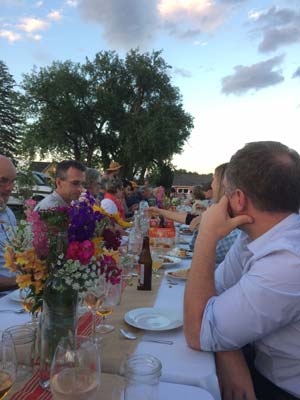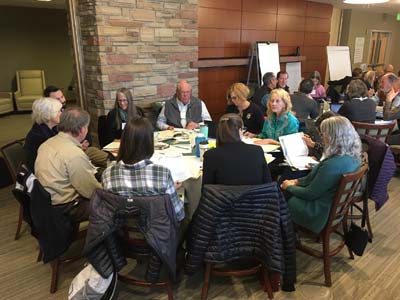When Conservation Happens Collaboratively
By:
Gregg ElliottIn this alpine desert where increasing demands for water were splashing up against less and less water every year, Heather learned the hard way that when it comes to natural resource conservation, ecosystems, soil, water and wildlife are the tangible parts. Mastering the people part is more difficult!
 Reflecting on that experience 10 years later, she feels there are more nuances to collaboration and natural resources management than she realized. “If you were going to start in natural resource conservation today, I would advise that the most important skills to learn are how to be a good leader, communicator, and listener.” She learned early on that helping people have difficult conversations and make tough choices was at the core of her work. Her whole life changed when she realized she had to become, not just technically competent, but a leader able to build teams and partnerships.
Reflecting on that experience 10 years later, she feels there are more nuances to collaboration and natural resources management than she realized. “If you were going to start in natural resource conservation today, I would advise that the most important skills to learn are how to be a good leader, communicator, and listener.” She learned early on that helping people have difficult conversations and make tough choices was at the core of her work. Her whole life changed when she realized she had to become, not just technically competent, but a leader able to build teams and partnerships.
Addressing the “people part” of conservation
For this very reason, the folks at Colorado State University established the Center for Collaborative Conservation (CCC) in 2008 and tapped another Heather, Heather Knight, to serve on its Executive Committee.
Heather Knight comes from rural agricultural roots in Australia, met her husband in New Zealand, and spent 25 years working as The Nature Conservancy’s Laramie Foothills Project Director for a public/private conservation effort on the Colorado/Wyoming border. After retiring in May 2016, she began working part-time with the CCC helping to expand efforts to support today’s conservation practitioners. An advisory team of practitioners provided solid guidance for the growing Practice Program to organize, in rapid succession, a nationwide needs assessment of collaborative conservation skills and tools, a database (known as CRAFT) of collaborative conservation learning opportunities and resources, and a Conservation Finance “Boot Camp” in collaboration with Yale’s Conservation Finance Network, co-hosted with the University of Wyoming’s Haub School for the Environment and CSU’s Business School.
The Center for Collaborative Conservation is an endowed center at Colorado State University, and they have three main foci, none of which is traditional in its approach: research, education, and practice.
The research program is pioneering what it calls “transformative science,” where researchers seek to serve people in the places they care about through listening to what communities want for stewardship of their resources, helping to craft those needs into a research question, connecting them to partners, then helping them to determine how to collect data, analyze it, and apply it!
This anti-ivory tower approach begins with the researcher asking, not a question, but listening to a community in need.
 The CCC education program focuses on building future leaders, whether young or old, to become transformative leaders who are both technically competent but also equally equipped with people skills to be better collaborators, leaders, communicators, facilitators, and relationship builders. Their competitive fellows program has trained people from the U.S. and 32 countries!
The CCC education program focuses on building future leaders, whether young or old, to become transformative leaders who are both technically competent but also equally equipped with people skills to be better collaborators, leaders, communicators, facilitators, and relationship builders. Their competitive fellows program has trained people from the U.S. and 32 countries!
Losers don’t forget
“The U.S.,” says Heather, “is actually a latecomer to collaborative conservation. Many other countries naturally conduct conservation collaboratively because their livelihoods are still more closely tied to the land.” Collaborative conservation began in the U.S. in the early 1990s, at least partially in response to the recognition that a strict reliance on policies and courts of law was not effective over the long-term.
“You always have winners and losers when you take the litigious approach to natural resource decision making. It rarely results in long-term solutions, because only part of the community perspective is incorporated into the solution, and so over time it gets eroded.”
People began recognizing that the more you include diverse community voices to help think through and figure out what’s best for both people and natural resources, the more you can get answers that most people will support and therefore will last.
“Listening to others, inviting people in so that you get the social and economic context, this gives us a much better base from which to make collective decisions and get buy-in from more people,” explains Heather. “It’s also an adaptive approach, because we don’t know everything!” Collaborative conservation is a more inclusive approach that addresses not just natural resources but also the social and economic concerns of the people who rely on those resources and, in many cases, manage them.
The third focus of the Center is practice: how to improve the collaborative conservation efforts underway in amazing places across the U.S., which is being facilitated by a long and varied list of practitioners that includes private landowners, agencies (federal, state, and local), nonprofits both big and small, tribes, diverse community groups, funders, academics, industries, and policy experts.
Connecting 7 states and co-convening with 6 large organizations
The latest initiative of the Practice Program is the Western Collaborative Conservation Network (WCCN), designed to connect community-based collaborative conservation efforts across seven states: Arizona, Colorado, Idaho, Montana, New Mexico, Utah and Wyoming. The WCCN promotes and supports community-based collaborative conservation efforts to strengthen and sustain healthy landscapes, vibrant communities and thriving economies.
In true collaborative fashion, the Network grew out of the CCC’s needs assessment, followed by an interactive workshop in which 65 people from across the country identified barriers and deficits that were constraining their abilities to achieve results. Many practitioners said, “We don’t have a regional scale entity that connects us and supports us on the collaborative capacity issues we all share, such as water, forest and rangeland management, and fire.”
Now with a leadership team of 35 people from 7 states and a Network co-designed by the University of Montana’s Center for Natural Resources and Environmental Policy, the WCCN includes 4 working groups: capacity building, regional funding, public policy, and awareness and engagement.
The WCCN’s inaugural Confluence 2020 meeting will bring together 200 people March 10-12, 2020 at Colorado State University. “It will be one of the biggest gatherings of community-based collaborative conservation groups in some time,” Heather says modestly.
The meeting themes are Connect, Convene, and Catalyze, again building on desires identified by community-based conservation practitioners:
-
Connect people through interactive sessions, shared case studies, and networking to foster new collaborations.
-
Convene organizations with peer-to-peer learning sessions that build skills to address hot topics, such as financial planning, storytelling, leadership, and partnerships.
-
Catalyze action through working sessions on critical regional capacity issues such as public policy, regional funding, and how to build more effective collaborations.
In response to the limitations expressed by many existing groups that they lacked the resources for attending more than one large meeting each year, the Confluence is “co-convening” with no less than six significant and well-established organizations that represent the range of natural resource needs across these states:
-
National Forest Foundation
-
Partners for Conservation
-
River Network
-
Western Governors Association
-
Western Landowners Alliance
-
Land Conservation Assistance Network
Empathy and trust take time
Developing empathy, learning to be open and trusting so that difficult conversations can happen, takes time.
“It isn’t fast! It’s a longer term investment. It’s about understanding we can all lose or we can all win, but we may not all get 100 % of what we want because there are many needs.
“We need collaboration now more than ever before,” Heather continues. “We need open, transparent, inclusive, diverse conversations and people willing to work together because there is more at stake now: there are more of us and more demands on lands and waters that sustain our lives and livelihoods. Natural resource management doesn’t lend itself well to short-term, quarterly decision-making. Neither do communities for that matter. Both communities and the living resources on which we all depend require deeper investment and more meaningful conversations to find solutions that are going to last.”
If you are ready, plenty of those conversations will be taking place next March in Colorado!